
PREV ARTICLE
NEXT ARTICLE
FULL ISSUE
PREV FULL ISSUE
HIGHLIGHTS FROM THE NEWMAN PART VII SALE
Maureen Levine and Lead Cataloguer Bruce Hagen prepared this list of highlights of Heritage's upcoming sale of part seven of the Eric
P. Newman collection. Thanks! -Editor
Eric P. Newman, author of the indispensable reference work, The Early Paper Money of America has been collecting and researching paper currency for over 75 years. Newman Part VII, the second in a series of currency sales, includes rare and historically significant World, Colonial, Continental, Obsolete and Confederate currency that has been off the market for decades. Highlights from the Signature session appear below. Items being sold are from the extensive collection of Eric P. Newman Numismatic Education Society (a Missouri not-for-profit corporation) and have been assembled over a period of 90 years. Proceeds of the sale of all items will be used exclusively for supplementing the Society’s museum operations and scholarly numismatic research efforts and for the benefit of other not-for-profit institutions selected by Eric P. Newman Numismatic Education Society for public benefit. Lot 18013: Great Britain - Bank of England £200 June 20, 1918
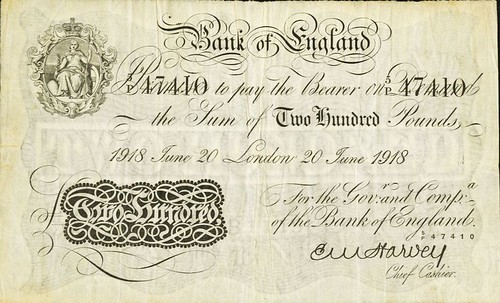
Exceedingly Rare Final £200 London "White Note" Great Britain - Bank of England £200 June 20, 1918 Pick 317, B209f. PCGS Fine 15PPQ. This is an exceedingly rare and important Bank of England note. London 1918 high-denomination "White Notes" are particularly rare. The £200 denomination was discontinued on June 20th of 1918, the same date as engraved on this note. Pam West lists it simply as "Rare" and without prices in English Paper Money. Newman acquired this note in the early 1990s from the grandchildren of a Russian banker who felt it would be confiscated if redeemed amidst the instability of the Russian Revolution. At the time, Newman's research pointed to it being the only example of the denomination known, but another example is pictured in West's book. It remains one of the most elusive "White Notes" for collectors and in comparison, the £1,000 denomination, which is also listed as "Rare," has not been offered at auction since 1996. It has the standard Bank of England design with Britannia at upper left. The denomination guilloche is at left, outlined TWO HUNDRED in script. At bottom is the engraved signature of Ernest Harvey, Chief Cashier. To read the complete lot description, see:
Lot 18113: Province of New Hampshire May 1, 1761 10 Shillings
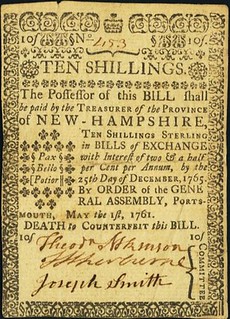 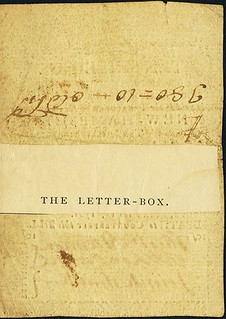
Bold and Likely Unique May 1, 1761 10 Shillings Province of New Hampshire May 1, 1761 10 Shillings Fr. NH-114. PCGS Extremely Fine 40 Apparent. This is an extraordinary New Hampshire Colonial note and the only example from the series we have seen or are aware of. Like the January 1, 1761 six pence offered here, this is the Newman 5th edition plate note. A larger bill than the six pence, with intricate ornamental patterns on the perimeter, a small crown at the top center, and the texts enclosed within. The small cartouche at the left center encloses the motto PAX BELLO POTIOR. The notes were payable by December 25, 1765 in 2.5% interest bearing Bills of Exchange. From the face, this has the appearance of a nearly "as made" note. Beautifully printed and mostly well margined. To read the complete lot description, see:
Lot 18248: Continental Currency April 11, 1778 $5 Yorktown Issue
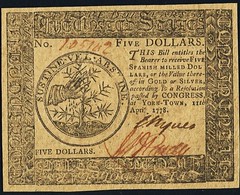 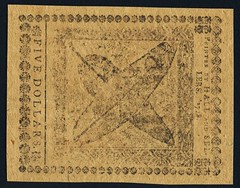
Superb Gem New 67PPQ Yorktown $5 Note Continental Currency April 11, 1778 $5 Yorktown Issue Fr. CC-72. PCGS Superb Gem New 67PPQ. The April 11, 1778 Resolution "at York-town" series is the rarest overall in the Continental Currency genre. This is the first of an exceptional quintet of Yorktown note denominations from the Newman collection. Several are the finest, or tied for the finest, graded and certified by PCGS. This $5 Yorktown is a stellar example with inspiring eye appeal. Interestingly, there are only two Uncirculated notes graded by PCGS. Both, including this example, are Superb Gem New 67PPQ. Very bold printing and wide, even margins are on both sides, and face-to-back registration is perfect. To read the complete lot description, see:
Lot 18479: Brownville, NE - Nemaha Valley Bank $1

Brownville, NE - Nemaha Valley Bank $1 Oct. 1, 1859 NE-10 G4a. Remainder. PCGS Very Fine 25. This is from the rare series of notes engraved and printed by Wellstood, Hay & Whiting. The notes printed by Toppan, Carpenter & Co. are readily encountered. The style is exceptional, and this has an unusual red color "Lazy 1" at the top center. The theme of progress is illustrated by the contrast (and similarities) of the farmers at left and the Native Americans at right. It is interesting that both couples were depicted with their dogs. An oval portrait of a woman wearing a hair ornament is at the base. This is an impeccably styled Territory of Nebraska type. Signed, but we believe falsely. To read the complete lot description, see:
Lot 18539: Boggy Depot, (Choctaw Nation, I. T., Western Arkansas)
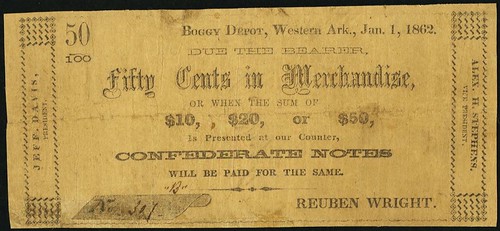
Unique and Historically Important Boggy Depot, Western Arkansas Note Boggy Depot, (Choctaw Nation, I. T., Western Arkansas) - Reuben Wright 50 Cents Jan. 1, 1862 Burgett 2, Durand-UNL. PCGS Fine 15 Apparent. A historic and unique territorial period scrip that is arguably the greatest of all Oklahoma-Indian Nation notes. This is the Burgett Plate Note, and we have not seen another example from the series. The note is fascinating on several levels and expresses a rich narrative. This is the only scrip we have seen with the designation "Western Arkansas." The Confederate theatre during the Trans-Mississippi Department era crossed the borders of what would become several American states after the Civil War. Boggy Creek, a trading center and active community, was strategically located between the Choctaw and Chickasaw nations. The Choctaws, Chickasaws and the Confederacy made a treaty in July, 1861 that formed a district with Boggy Depot as the seat. The note itself is printed on brown rag paper and its overall style is similar to some Mayer Brothers notes from Arkansas. The upper left has the 50/100 fraction. Location and engraved date are at the upper right. The Gothic denomination "Fifty Cents in Merchandise" is across at top center, with the rest of the obligation beneath. Highlighted, toward the bottom, is the bolded CONFEDERATE NOTES, for which the notes could be redeemed. The note was not signed on the face, but the issuer name REUBEN WRIGHT appears at lower right in all capital letters. The most fascinating diagnostic of this note is that the end panels are formed by an interesting pattern. Perpendicular at the left is JEFF. DAVIS, /PRESIDENT and at the right, ALEX. H. STEPHENS, /VICE PRESIDENT. The patriotic reference to the Confederate Executive branch would certainly communicate loyalty. The blank back is countersigned by Reuben Wright. Wright was an important and wealthy man at the beginning of the War. To read the complete lot description, see:
Lot 18766: Confederate States of America - T1 1861 $1000 Montgomery Issue

Confederate States of America - T1 1861 $1000 Montgomery Issue PF-1, Cr. 1. PCGS Very Fine 35. The Confederate States T1 $1000 Montgomery Issue note is an iconic rarity in the American paper money canon. The Eric P. Newman example is an illustrious member of the Montgomery note quartet and boasts, along with his other denominations, the famous "Colonel" E.H.R Green collection pedigree. Its phenomenal vibrancy, sharp printing and complete margins, give a first impression of an Uncirculated note. More importantly, it is not cancelled in any manner at all. Of the 607 printed and issued, this is among the finest looking $1000 Montgomery notes known. The combination of remarkable appearance and stellar pedigree presents an exceptional offering. This very distinctive type has a seemingly simple layout, but reveals state-of-the-art engraving intricacies upon close examination. The richness of the National Bank Note Company engraved black printing is amplified by the green tinted cycloidal guilloche configurations created by Cyrus Durand's patented spiral lathe machines. There are currently 138 $1000 Montgomery notes recorded by Pierre Fricke on a census that likely commenced in the 1960s by Grover Criswell and continues to this day. Most are low grade, cancelled with holes or cut cancelled; they have often received repairs to improve their appearance. This example is far ahead of the majority of existing notes and is the finest uncancelled note to appear at public auction in recent memory. To read the complete lot description, see:
Lot 18787: Confederate States of America - T35 1861 $5
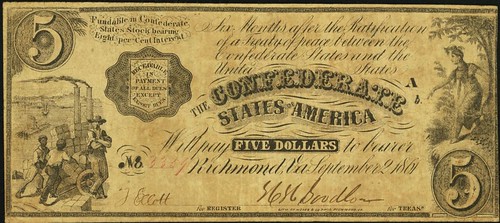
An Exemplary "Indian Princess" Note Confederate States of America - T35 1861 $5 PF-1, Cr. 271. PCGS Very Fine 25. Over the many decades that Eric P. Newman has actively collected and studied paper money, countless numismatic events and shows have been held. At those gatherings, perhaps the two most memorable paper money words uttered were "Indian Princess." This classic American currency note has maintained its lofty stature for well over a century. In 1883, John Haseltine declared in the sale featuring Harold's Newlin's Montgomery (or "first issue") notes that the "Indian Princess" was the rarest in the Confederate series. Like the "Grand Watermelon" in the Federal series, its deserving nickname and rarity make it a natural subject for all numismatists to discuss. The layout and plate were developed from the Bank of Charleston $5 plate originally engraved by Draper, Toppan, Longacre & Co. that was sent to Hoyer & Ludwig. They used the "Princess" at the right, and counters, but developed the rest of the plate using other elements. At the lower left, young men, one with a wary expression, transport bales of cotton. They are overseen by a smoking man with arms crossed wearing a wide-brimmed hat (George Tremmel published a study of plate diagnostics, including the hat). A Native American princess on a high point looks off into the distance. The titles and obligations are crowded into the right center with multiple arced flourishes over the block with white outlined FIVE DOLLARS and under the title. Below the princess and above the wharf scene are "5" dies. An additional obligation die with shield upon it is left of the titles. Plate Ab., serial number 3359. To read the complete lot description, see:
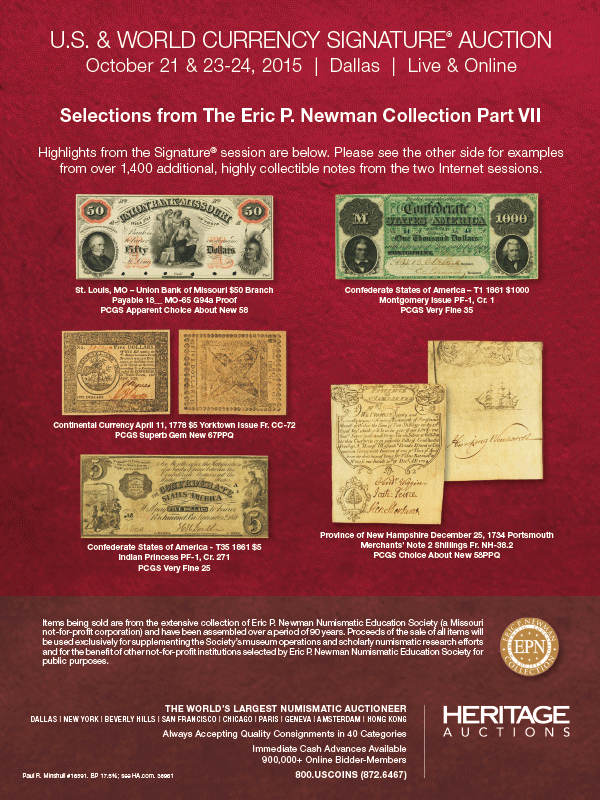 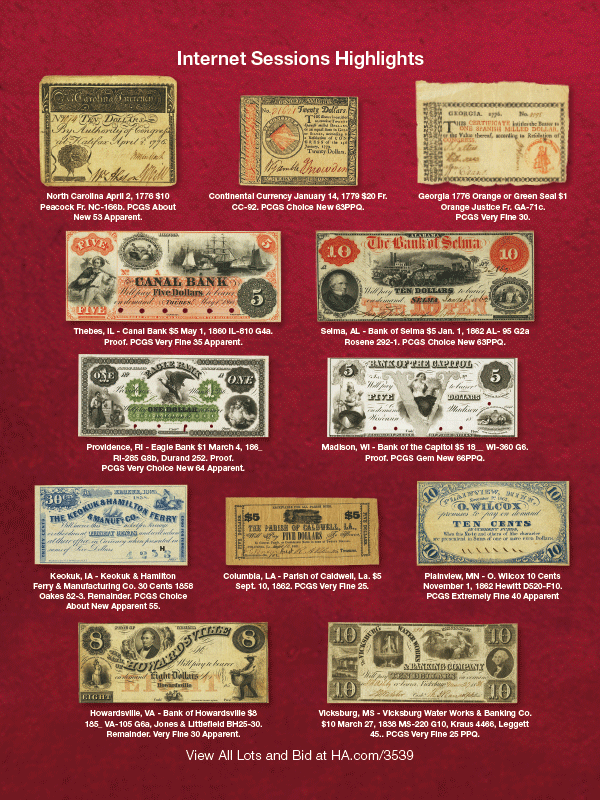
Wayne Homren, Editor The Numismatic Bibliomania Society is a non-profit organization promoting numismatic literature. See our web site at coinbooks.org. To submit items for publication in The E-Sylum, write to the Editor at this address: whomren@gmail.com To subscribe go to: https://my.binhost.com/lists/listinfo/esylum All Rights Reserved. NBS Home Page Contact the NBS webmaster 
|